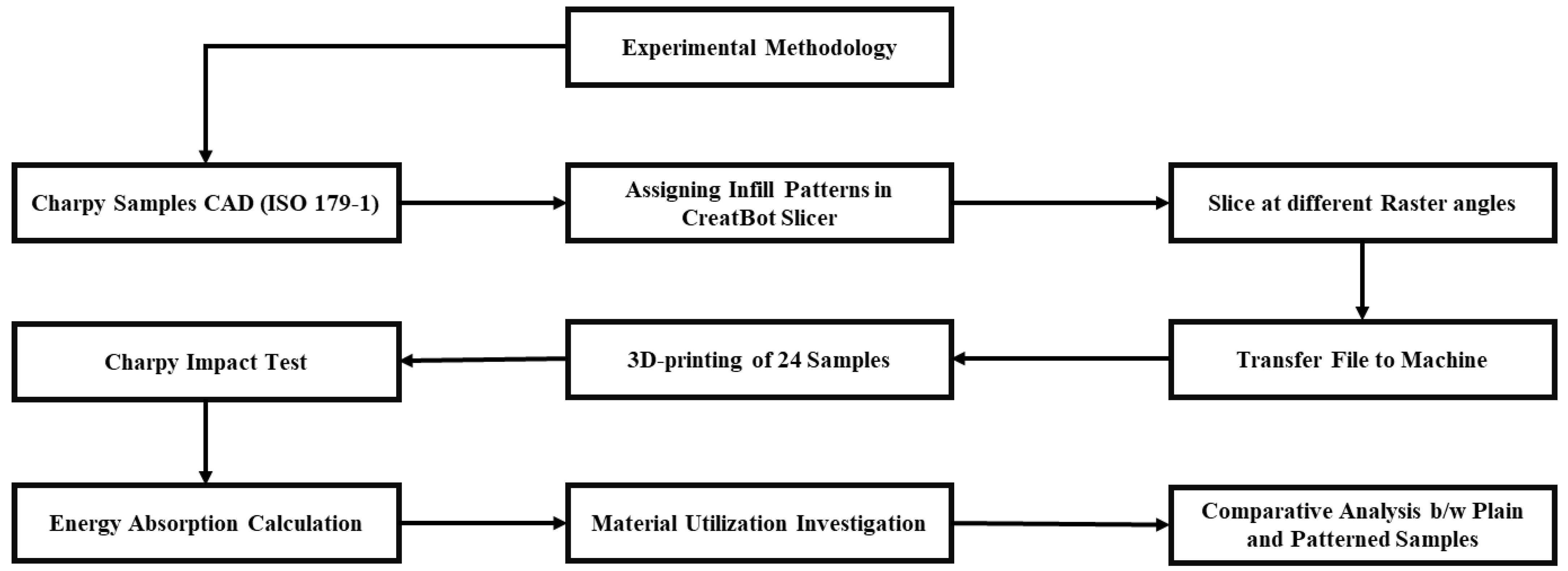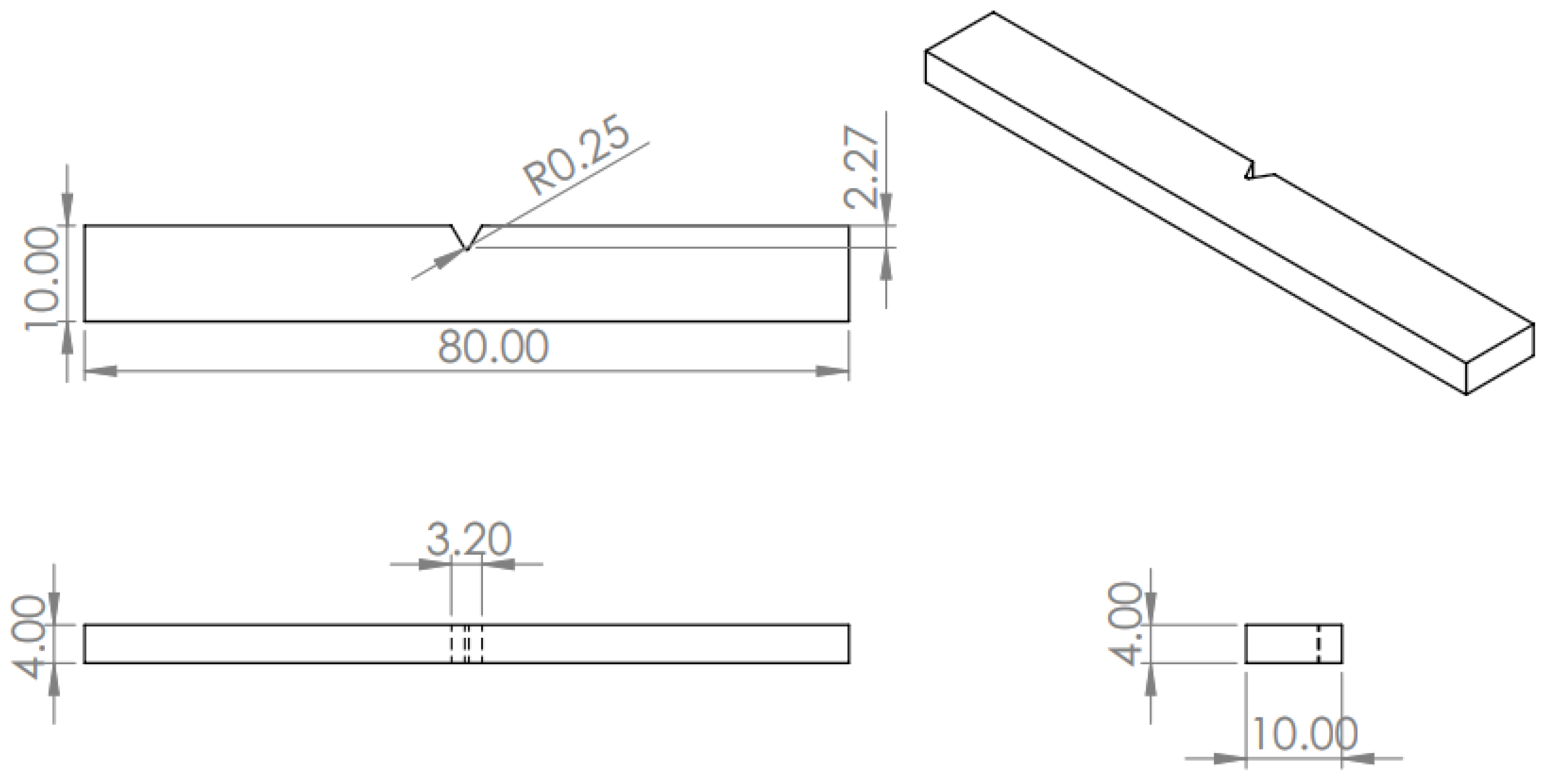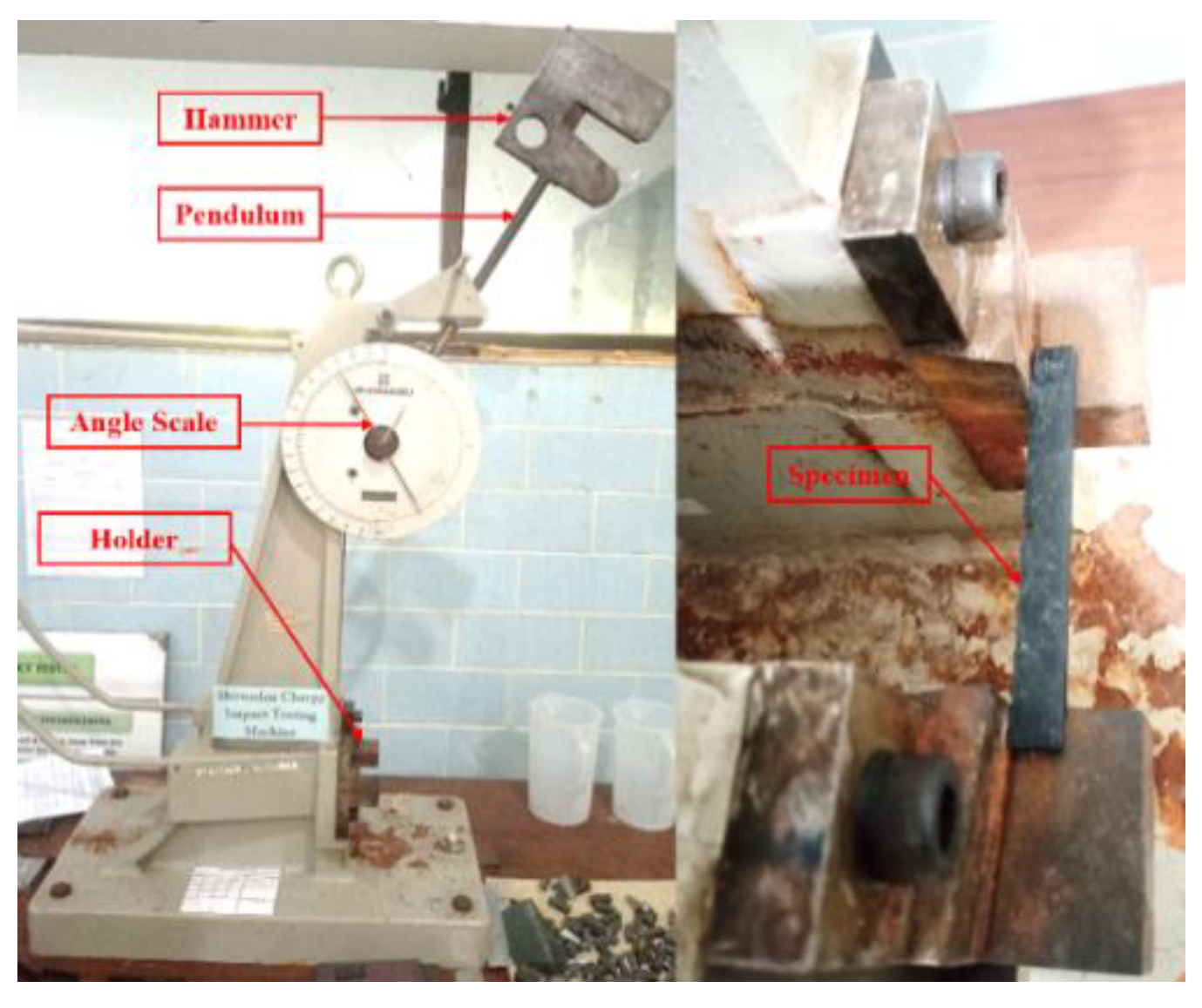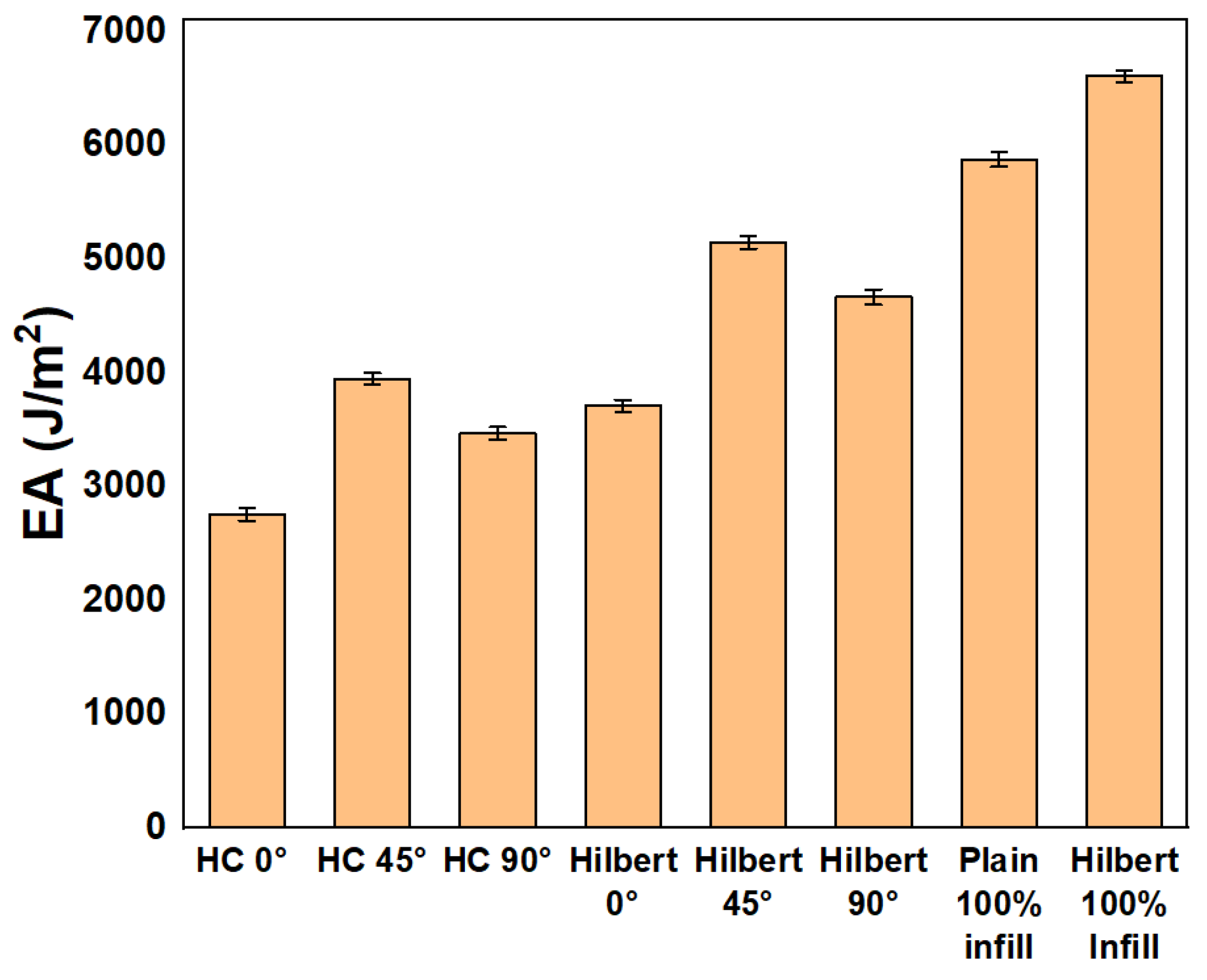Optimizing Impact Toughness in 3D-Printed PLA Structures Using Hilbert Curve and Honeycomb Infill Patterns †
Abstract
:1. Introduction
2. Materials and Methods
2.1. Manufacturing Method
2.2. Charpy Test
- E is the energy absorption;
- W is the weight of the hammer;
- D is the distance from the axis to the center of gravity/moment arm.
- is the angle after the hammer drop.
- is the angle before the hammer drop.
3. Results and Discussion
Effect of Raster Angles and Infill Patterns
4. Conclusions
Author Contributions
Funding
Institutional Review Board Statement
Informed Consent Statement
Data Availability Statement
Acknowledgments
Conflicts of Interest
References
- Ashfaq, B.; Hussain, G.; Khan, M.B.; Alkahtani, M.; Wei, H. A novel design of mono and bi-cells based hybrid auxetic structures and assessment of their compressive properties. J. Mater. Res. Technol. 2024, 28, 1620–1632. [Google Scholar] [CrossRef]
- Ashfaq, B.; Hussain, G.; Khan, M.B.; Ilyas, M. Mechanical characterization of innovative 3D-printed auxetic (NPR) structures: Role of considering anisotropy on accuracy of numerical modeling. Int. J. Adv. Manuf. Technol. 2024, 130, 4845–4859. [Google Scholar] [CrossRef]
- Parandoush, P.; Lin, D. A review on additive manufacturing of polymer-fiber composites. Compos. Struct. 2017, 182, 36–53. [Google Scholar] [CrossRef]
- Gohar, S.; Hussain, G.; Ilyas, M.; Ali, A. Performance of 3D printed topologically optimized novel auxetic structures under compressive loading: Experimental and FE analyses. J. Mater. Res. Technol. 2021, 15, 394–408. [Google Scholar] [CrossRef]
- Tobe, F. Design Aircraft Faster with FDM and 3D Printing. Design World Online. Available online: https://www.designworldonline.com/design-aircraft-faster-fdm-3d-printing/ (accessed on 8 January 2024).
- Alaimo, G.; Marconi, S.; Costato, L.; Auricchio, F. Influence of meso-structure and chemical composition on FDM 3D-printed parts. Compos. Part B Eng. 2017, 113, 371–380. [Google Scholar] [CrossRef]
- Es-Said, O.S.; Foyos, J.; Noorani, R.; Mendelson, M.; Marloth, R.; Pregger, B.A. Effect of layer orientation on mechanical properties of rapid prototyped samples. Mater. Manuf. Process. 2000, 15, 107–122. [Google Scholar] [CrossRef]
- Tsouknidas, A.; Pantazopoulos, M.; Katsoulis, I.; Fasnakis, D.; Maropoulos, S.; Michailidis, N. Impact absorption capacity of 3D-printed components fabricated by fused deposition modelling. Mater. Des. 2016, 102, 41–44. [Google Scholar] [CrossRef]
- Tanveer, M.Q.; Haleem, A.; Suhaib, M. Effect of variable infill density on mechanical behaviour of 3-D printed PLA specimen: An experimental investigation. SN Appl. Sci. 2019, 1, 1701. [Google Scholar] [CrossRef]
- Tunçel, O. Optimization of Charpy Impact Strength of Tough PLA Samples Produced by 3D Printing Using the Taguchi Method. Polymers 2024, 16, 459. [Google Scholar] [CrossRef] [PubMed]
- Ahmed, H.; Hussain, G.; Gohar, S.; Ali, A.; Alkahtani, M. Impact toughness of hybrid carbon fiber-PLA/ABS laminar composite produced through fused filament fabrication. Polymers 2021, 13, 3057. [Google Scholar] [CrossRef] [PubMed]
- Dakhil, G.Y.; Salih, R.M.; Hameed, A.M. The influence of infill pattern and infill density on the (tensile, flexural and impact) strength of 3D printed polymers. In AIP Conference Proceedings; AIP Publishing: Melville, NY, USA, 2022; Volume 2660. [Google Scholar]






| Printing Parameter | Defined Values |
|---|---|
| Layer height | 0.25 mm |
| Nozzle temp °C | 205 |
| Build platform temp °C | 65 |
| Printing speed | 35 mm/s |
| Infill density | 40% |
| Samples | β | Delta (cosβ – cos α) | EA (J) | EA (KJ/m2) | % Diff Plain vs. Infill |
|---|---|---|---|---|---|
| Honeycomb 0° | 149.8 ± 0.03 | 0.010 ± 0.02 | 0.082 ± 0.0025 | 2.76 ± 0.005 | 52.93 |
| Honeycomb 45° | 149.3 ± 0.01 | 0.014 ± 0.01 | 0.11 ± 0.0019 | 3.95 ± 0.025 | 40.28 |
| Honeycomb 90° | 149.5 ± 0.01 | 0.012 ± 0.01 | 0.10 ± 0.002 | 3.47± 0.020 | 40.90 |
| Hilbert 0° | 149.4 ± 0.01 | 0.013 ± 0.01 | 0.11 ± 0.0015 | 3.71 ± 0.012 | 43.88 |
| Hilbert 45° | 148.8 ± 0.02 | 0.019 ± 0.01 | 0.15 ± 0.0012 | 5.15 ± 0.022 | 12.39 |
| Hilbert 90° | 149 ± 0.01 | 0.017 ± 0.01 | 0.14 ± 0.0025 | 4.67 ± 0.012 | 20.60 |
| Plain 100% | 148.5 ± 0.04 | 0.021 ± 0.03 | 0.17 ± 0.0041 | 5.88 ± 0.054 | 0 |
| Hilbert 100% | 148.2 ± 0.03 | 0.024 ± 0.03 | 0.19 ± 0.002 | 6.61 ± 0.005 | 11.11 |
Disclaimer/Publisher’s Note: The statements, opinions and data contained in all publications are solely those of the individual author(s) and contributor(s) and not of MDPI and/or the editor(s). MDPI and/or the editor(s) disclaim responsibility for any injury to people or property resulting from any ideas, methods, instructions or products referred to in the content. |
© 2024 by the authors. Licensee MDPI, Basel, Switzerland. This article is an open access article distributed under the terms and conditions of the Creative Commons Attribution (CC BY) license (https://creativecommons.org/licenses/by/4.0/).
Share and Cite
Ali, M.U.; Nadeem, A.; Ashfaq, B.; Ullah, S.; Waseem, M.; Aslam, M.A.; Alam, Q.A. Optimizing Impact Toughness in 3D-Printed PLA Structures Using Hilbert Curve and Honeycomb Infill Patterns. Eng. Proc. 2024, 75, 27. https://doi.org/10.3390/engproc2024075027
Ali MU, Nadeem A, Ashfaq B, Ullah S, Waseem M, Aslam MA, Alam QA. Optimizing Impact Toughness in 3D-Printed PLA Structures Using Hilbert Curve and Honeycomb Infill Patterns. Engineering Proceedings. 2024; 75(1):27. https://doi.org/10.3390/engproc2024075027
Chicago/Turabian StyleAli, Muhammad Usman, Azka Nadeem, Babar Ashfaq, Shafi Ullah, Muhammad Waseem, Muhammad Arbab Aslam, and Qazi Amaan Alam. 2024. "Optimizing Impact Toughness in 3D-Printed PLA Structures Using Hilbert Curve and Honeycomb Infill Patterns" Engineering Proceedings 75, no. 1: 27. https://doi.org/10.3390/engproc2024075027






